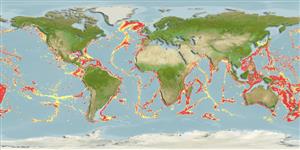>
Notacanthiformes (Halosaurs and deep-sea spiny eels) >
Halosauridae (Halosaurs)
Etymology: Aldrovandia: Taken from Ulisse Aldrovandi, (1522-1605), a Renaissance naturalist and physician noted by his systematic and accurate observations of plants and animals (Ref. 45335).
More on author: Günther.
Environment: milieu / climate zone / depth range / distribution range
Ecología
marino bentopelágico; rango de profundidad 730 - 2560 m (Ref. 3974). Deep-water
Circumglobal, tropical to temperate. Atlantic and Indo-Pacific, except Mediterranean.
Tamaño / Peso / Age
Maturity: Lm ? range ? - ? cm
Max length : 60.0 cm TL macho / no sexado; (Ref. 41039)
Espinas dorsales (total): 1; Radios blandos dorsales (total): 10-12. Body white to grey-brown in color, underside darker (Ref. 3974). Insertion of the pelvic fin only slightly anterior to the origin of the dorsal fin. Lacks scale on the opercle (Ref. 37108).
Occurs on the middle and lower slope primarily above the 4°C isotherm. Hovers within a few meters of substrate, parallel to it or inclined at varying angles (Ref. 6727). Feeds on polychaetes, pelecypods, amphipods and other benthic prey (Ref. 6727).
Life cycle and mating behavior
Madurez | Reproducción | Puesta | Huevos | Fecundidad | Larva
Sulak, K.J., 1990. Halosauridae. p. 126-132. In J.C. Quero, J.C. Hureau, C. Karrer, A. Post and L. Saldanha (eds.) Check-list of the fishes of the eastern tropical Atlantic (CLOFETA). JNICT, Lisbon; SEI, Paris; and UNESCO, Paris. Vol. 1. (Ref. 4448)
IUCN Red List Status (Ref. 130435)
Threat to humans
Harmless
Human uses
Más información
Nombres comunesSinónimosMetabolismoDespredadoresEcotoxicologíaReproducciónMadurezPuestaAgregación para la puestaFecundidadHuevosEgg development
ReferenciasAcuiculturaPerfil de acuiculturaRazasGenéticaElectrophoresesheritabilidadEnfermedadesProcesamientoNutrientsMass conversion
Herramientas
Special reports
Download XML
Fuentes de Internet
Estimates based on models
Preferred temperature (Ref.
123201): 2.5 - 6.6, mean 4 °C (based on 1890 cells).
Phylogenetic diversity index (Ref.
82804): PD
50 = 0.5156 [Uniqueness, from 0.5 = low to 2.0 = high].
Bayesian length-weight: a=0.00389 (0.00180 - 0.00842), b=3.12 (2.94 - 3.30), in cm total length, based on all LWR estimates for this body shape (Ref.
93245).
Nivel trófico (Ref.
69278): 3.3 ±0.40 se; based on food items.
Resiliencia (Ref.
120179): Bajo, población duplicada en un tiempo mínimo de 4.5-14 años (Assuming tmax>10).
Fishing Vulnerability (Ref.
59153): Moderate vulnerability (44 of 100).
Nutrients (Ref.
124155): Calcium = 10.7 [2.9, 38.3] mg/100g; Iron = 0.337 [0.111, 0.857] mg/100g; Protein = 1.6 [0.0, 5.5] %; Omega3 = 0.308 [0.115, 0.819] g/100g; Selenium = 20.5 [6.1, 75.9] μg/100g; VitaminA = 11.8 [2.3, 59.1] μg/100g; Zinc = 0.407 [0.209, 0.831] mg/100g (wet weight);
